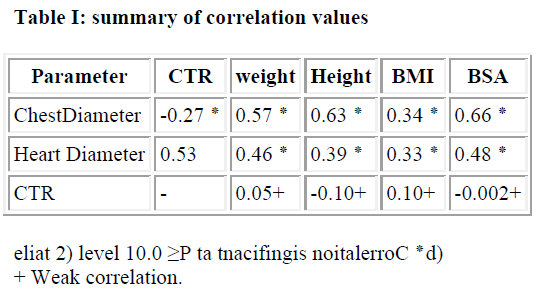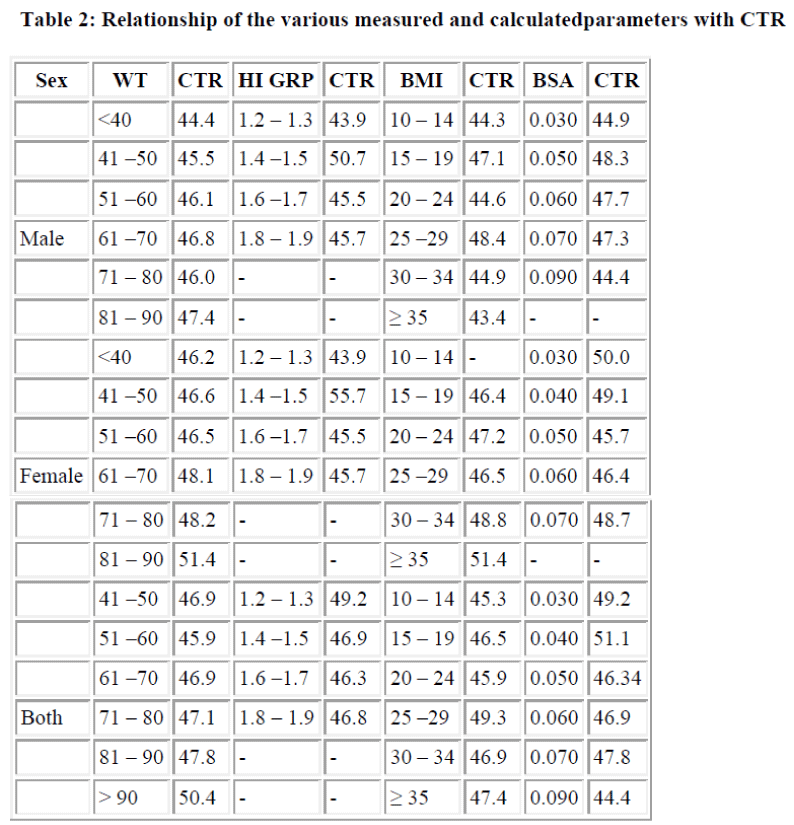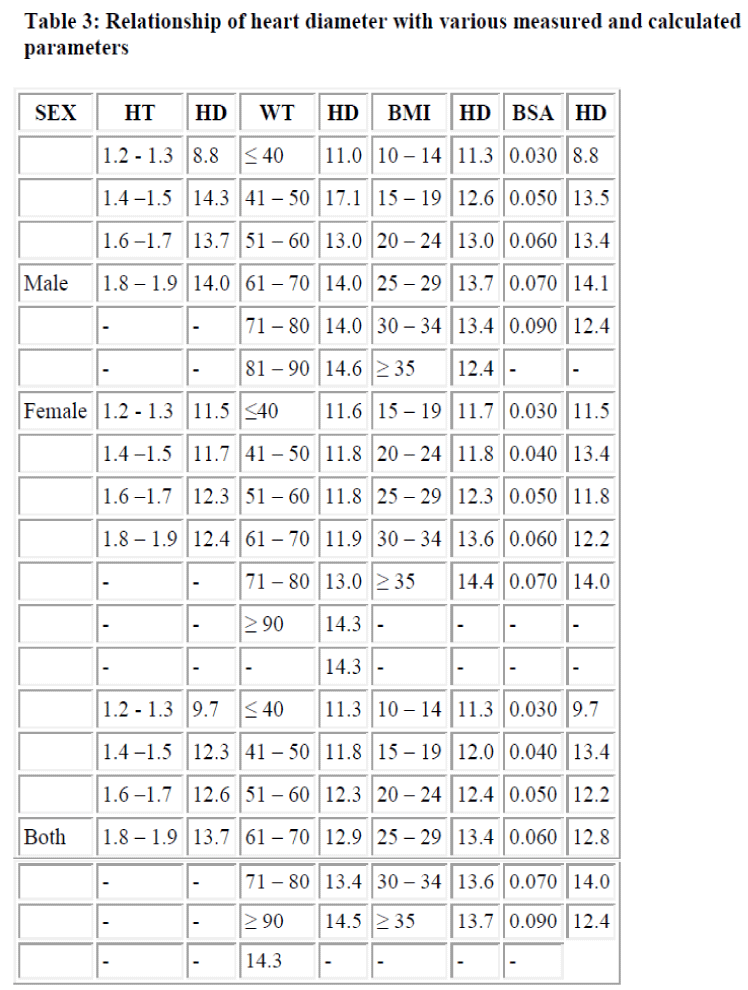ISSN: 0970-938X (Print) | 0976-1683 (Electronic)
Biomedical Research
An International Journal of Medical Sciences
- Biomedical Research (2007) Volume 18, Issue 2
Cardiothoraic ratio and body habitus in a Nigerian population
ANYANWU G.E.1,*, ANIBEZE C.I.P.2, AKPUAKA F.C.2
1Department of Anatomy, Enugu State University, College of Medicine, Enugu, Nigeria
2Department of Anatomy, Abia State University College of Medicine, Abia, Nigeria
- *Corresponding Author:
- G.E. Anyanwu
Department of Anatomy Enugu State University
College of Medicine Enugu
Nigeria
E-mail: anyanwugemeks@yahoo.com
Accepted date: March 22, 2007
Results of previous research studies have presented racial difference as a function of body size. Several literatures on racial variation of heart sizes also abound. This research is aimed at determining the relationships of the various indices of body size with the different indices of heart size in a Nigerian population. 1885 male and female Nigerians of ages 4 to 80 years after physical examinations were enrolled for the study. Their PA chest radiographs were obtained. Weight, height, BMI, and BSA, showed various levels of statistically significant correlation with cardiothoracic ratio; CTR, heart and chest diameters. The research presents use of heart diameter over use of CTR in predicting heart size using body size. Amongst all the indices of body size, BSA has been presented to be the strongest predictor of heart diameter followed by weight.
Keywords
Heart diameter, Body habitus, Chest radiograph, Cardiothoracic ratio.
Introduction
The ratio of the transverse cardiac diameter (the horizontal distance between most rightward and leftward borders of the heart as seen on a poster-anterior (PA) Chest radiograph) with the transverse chest diameter (measured from the inside rib margin at the widest point above the costophrenic angles on a PA chest film) is today commonly referred to as the cardiothoracic ratio (CTR). This ratio has over time stood out as the simplest and most common way of ascertaining the heart size from the chest radiograph. Ability to measure the heart size has provided very objective means for clinical investigations, serial evaluation and population studies of cardiac size, despite known limitations [1,2,3].
Comeau and White [4] in their study of Body and heart sizes in twins made strong association between heart size and body size. They presented racial difference as a function of body size. This research therefore has been designed to determine the effects of various indices of body size on the size of the heart within the Nigerian population.
Materials and Method
A total of 1885 Nigerians in the Southeast after physical examinations were used for this study. Sampled population included both sexes from the age of four years and above. This sample was selected from candidates that came for chest X-ray examination as a result of requirements such as preemployment, preadmission, visa application and volunteer candidates without any cardiovascular disease symptoms.
The research centres for this study were; The University of Nigeria Teaching Hospital Enugu, Nigeria and Hansa special Diagnostic centre Enugu Nigeria. The research materials used for this study were; the X-ray machine, Weighing balance, Height scale, meter rule and a sphegmomanometer.
Measurements of the candidate’s weight (in kilogram), height (in meters) and blood pressure (mmHg) were obtained. The heights were measured to the nearest 0.01 meters, while the weights were done to the nearest 0.1-kilogram. The heights and weights were done without foot wears. The weights were measured with minimum clothing (i.e. only ward gowns). Blood pressure values accepted to be normal for this study were cases where the systolic blood pressure fell between 110 and 145 mmHg, and the diastolic fell between 60 and 100mmHg.
Postero-anterior chest radiographs of the candidates were obtained. The focus film distance was 1.8m, and exposures were made at normal quiet inspiration. Out of the 1885 candidates enrolled for this study, only 1018 radiographs were used for this study. Such rejected radiographs were those that showed any of the following; thoracic wall deformity, inadequate inspiration, Over expanded chest, inability to determine one or both heart borders with confidence and significant rotations.
The horizontal distance between the most rightward and leftward borders of the heart, measured out from the chest radiograph was used as the transverse diameter of the heart while the horizontal distance inside the rib at the widest point above the costophrenic angles, measured from the chest radiograph was used as the transverse chest diameter.
Result
The males made up 510 of the population size while the females made up the rest 508. The weights were broken into 10-kilogram intervals. The mean weight for the distribution was 61.21 +16.6 kg, The modal weight group for male population and also for the distribution was the weight group 61-70, while 51-60 was for the females only.
The height groups were broken into 0.2 meter intervals. The mean height for the distribution gave 1.62 + 0.11. The modal height group for the males and females and also for the distribution was the height group 1.6-1.7.
Body mass Index (BMI) was derived from the weight in kilograms and height in meters using the formula:
BMI = weight / (Height)2
The BMI values for the distribution were broken into groups of five (5) unit intervals. The distribution recorded a mean BMI of 22.96+5.8. The modal BMI group for both sexes was the 20.24 group while the least for both was group above 35.
Body surface area (BSA) was derived from the weight (w), measured in kilogram and height (H), measured in meter using the formula:
BSA=W0.425×H0.725×0.007184.
The distribution recorded a mean BSA of 0.058. The modal BSA group for both sexes was the 0.06 group.
Discussion
Prior to this study, several observations have been made that heart size in normal individuals is dependent principally on body build, and that genetic, racial and environmental factors are usually important, majorly because they affect the body structure [4,5]. In the present study, various indices of body size such as weight, height, BMI and BSA have shown various levels of correlation with the different indices of heart size as used in this study such as heart diameter, chest diameter and cardiothoracic ratio. This research has shown that in predicting heart size using body size, that use of heart diameter is more reliable than the use of cardiothoracic ratio. This is evidenced by the weak relationship between CTR and all the indices of body size used in this study. Though height has always been used as an independent variable in standard tables of heart diameter [3,6,7], however, the present study shows that both weight and height showed strong relationship with heart diameter and the weight showed a greater influence. This work is in agreement with Oberman’s observation [3] of strong correlation of weight and heart diameter but disagrees in totality with his nonsignificant observations of direct correlation of height with heart diameter.
The findings of the present study are in conformity with the observations of Smith and Bloeder [8] who suggested that the body surface area is a more suitable index for combining the factors of weight and height. Both body mass index and body surface area, which are derivatives of weight and height showed strong association with heart diameter. But in the prediction of heart diameter body surface area showed greatest reliance over BMI, weight and height.
In conclusion, this research presents heart diameter as a better index over cardiothoracic ratio when predicting heart size using the various indices of body size. It also presents body surface area as the strongest predictor of heart diameter followed by weight.
References
- Schwedel JB. Clinical roentgenology of the heart, New York 1946; Paul B Houser, Inc
- Amundsen P; 1959, Diagnostic value of conventional radiological examination of the heart in Adults. Acta Radiol 1959; (suppl.181): 1.
- Obnerman A, Allen RI Thomas KI et al, 1967; Heart sixes of Adults in a Natural population of Tecumesh, Michigan. Circulation 1967; XXXX.
- Commeau W.J, white PD, 1939, Body size and Heart size. Am Heart J 1939; 17:616.
- Kerwin AJ, 1943, Observations on the Heart size of Natives living At High Altitudes. Am Heart J 1949; 69-80.
- Ungerleinder H.E, & Gubner RI 1942; Evaluation of heart size measurements. Am Heart J 1942; 24, 494-510.
- Bainton JH, 1932, The transverse diameter of the heart. Am Heart J 1932; 7: 331.
- Smith, H. W and Bloedern, W. A. 1933: U S Naval Medicine. Bull 1933; 17 xii; 219.
- Nickol K, and Wade AJ, 1982; Radiographic Heart size and cardiothoracic ratio in three ethnic groups; a basis for a simple screening test for cardiac enlargement in men. BJR 1982; 55: 399.


